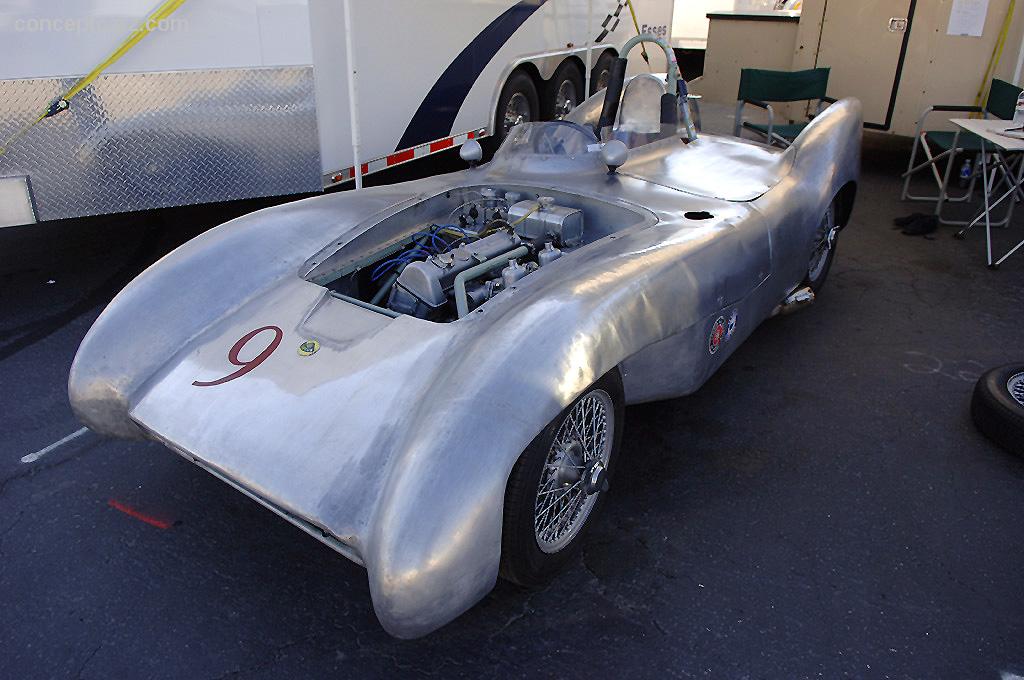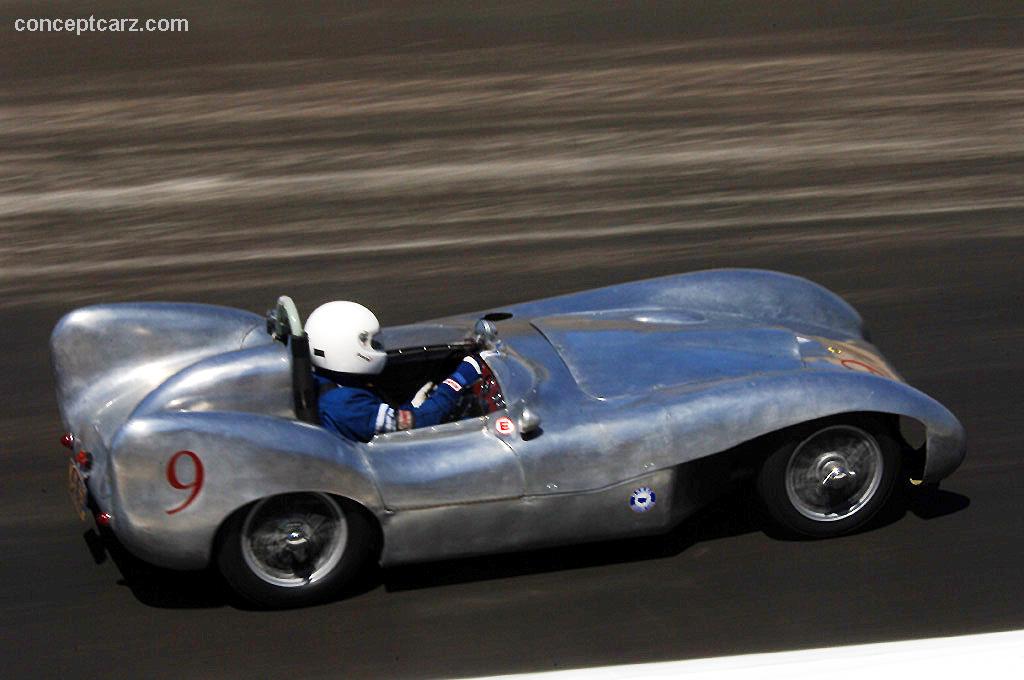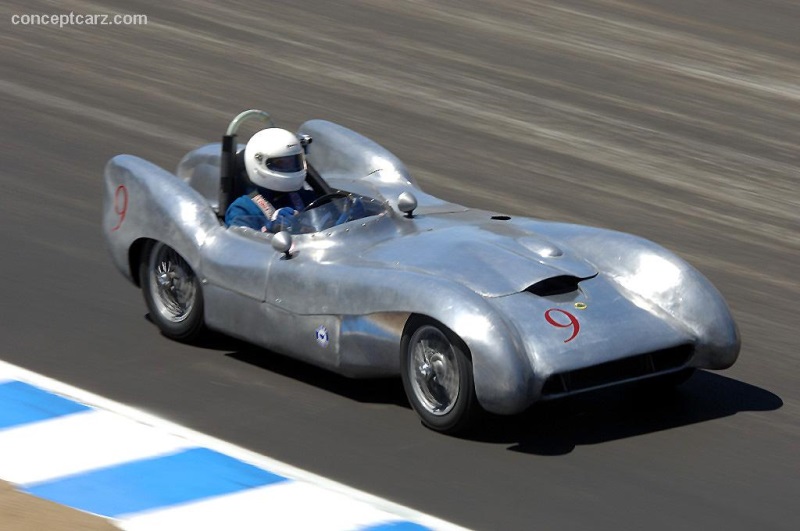Sports Car Racing was gaining momentum and popularity in the post World War II era, and a number of manufacturers and specialty-body creators began building entrants for this sport. For 1955, Colin Chapman, the founder of Lotus, planned a new and improved racer that would take full advantage of the Coventry Climax FWA engine which first appeared in 1954. The Coventry Climax company main source of business was in fork-lift trucks at the time. During the 1930s, they had built a strong business providing engines for marque's such as Triumph. During the 1950s, they focused on providing a competitive engine which aided great Britain in becoming one of the leading nations in the motor racing sport.
Chassis #: 105
View info and historyThe Coventry Climax FWA engine, meaning Feather Weight Automotive, was originally designed for a portable fire-pump. In this guise, it produced 38 horsepower. In its racing form, the horsepower was boosted to over 70. As time progressed, further improvements were made to the engine, which increased the horsepower even further, nearing 85 horsepower. The factory works cars were given MG engines.The chassis design for the MKIX was courtesy of Mac McIntosh. The design was similar to the Lotus Eleven, but incorporated a space-frame chassis with small tube size which helped in the reduction of weight. Production cars had a slightly different setup. The suspension was comprised of a conventional setup with coil springs, damper units, and radius arms. The works cars were given magnesium-alloy bodies. There were three fuel tank sizes available to the cars. The idea was to match the appropriate fuel tank to the length of the race. For the shorter races, the cars were given a seven-gallon fuel tank, which maximized the potential of the lightweight Climax engines. For the longer races, the cars were given 19-gallon fuel tanks, which meant fewer pit stops. A 12-gallon fuel tank was also available. 
Chassis #: 105
View info and historyProduction cars were given a Ford steering setup, while the factory works cars, and a few of the first Climax-powered cars, were given special magnesium-alloy steering housings. The MG-powered Works cars were originally given larger 11-inch turbo-finned drums. Later, these were changed in favor of 9-inch Girling discs. The two Works cars that ran at Sebring had 9-inch Alfin drum brakes with hydraulic assistance. The production cars brakes varied; some had Ford-Girling cable-operated brakes, some had hydraulically operated brakes, and some were later converted to discs.The production cars were given steel knock-off wire wheels, while the works cars had Borranni aluminum alloy wheels with Rudge knock-off hubs. Some of the privateers switched to this configuration as well.The first Lotus Mark IXs constructed were sent to the United States to contest the 12 Hours of Sebring race. The cars, running in the 1100cc class, ran strong throughout t the race. The car driven by Scott and Samuelson was forced to retire prematurely due to mechanical difficulties after the car was driven off course. The other car driven by Miller and Rabe ran well until it entered the pitts. It had been brought into the pitts so the crew could fix the vehicles lights after it had been driven into a bale of hay. Once inside the pitts, the car refused to re-start.
Chassis #: 105
View info and historyThe MG-powered car was raced by Chapman at the British Empire Trophy at Oulton Park but was forced to retire due to overheating problems. This problem reared its head again in another race. To solve the problem, a new MG engine with dry sump lubrication with the oil tank mounted in the passenger footwell, as adapted to the car. This seemed to fix the problem.The cars did well in the 1500cc category, often providing podium finishes for its drivers. The Lotus Mark IX was entered in the LeMans race, and piloted by Chapman and Ron Flockhart. The team manager at the time was John Eason Gibson. The car ran well in the 1100cc class, initially leading the pack for part of the race. Eventually, the cars fortunes reversed, and the Lotus began loosing ground. More time was lost in the pitts, as the time quickly tried to resolve a clutch problem. More problems for the car occurred when Chapman bent the front wing while going around a turn. The turn, Arnage, would cause more problems for Chapman later in the race, as he slid off course and then reversed back onto the circuit. The proper signal had not been supplied to Chapman, and he was immediately disqualified from the race.The Mark IX's were constructed in two versions, the Coventry Climax version and a Ford side-valve engine with a Ford three-speed gearbox. Many other Ford components were used throughout the vehicle, including the rigid rear axle and Girling cable brakes. The Ford-powered cars became known as the 'Club' cars, while the Coventry-Climax machines were dubbed 'LeMans.' The cars were offered at a very reasonable price, and to save costs on taxes, many were supplied in component form, leaving it up to the buyer to assemble the product. 
Chassis #: 105
View info and historyThe cars continued their racing resume in numerous British events including Brands hatch and the British Grand Prix. Most of their accomplishments were in minor races, though a few international races were contested. The minor races provided the team with opportunities to fine-tune their product to work through mechanical difficulties. They were unable to put their products through proper testing, so most of the cars weaknesses were revealed on the racing circuit. As time progressed, so did the vehicle. The experience and successes of the Mark IX were continued in subsequent Lotus cars.
by Daniel Vaughan | Jun 2007

Chassis #: 105
View info and history

Chassis #: 105
View info and history

Chassis #: 105
View info and history

Chassis #: 105
View info and history
by Daniel Vaughan | Jun 2007
1955 Lotus Mark IX Vehicle Profiles
Recent Vehicle Additions
Related Automotive News
The Lights Go Green On Six 1958 Vanwall Formula One Continuation Cars
Sixty-two years to the day since Vanwall claimed the worlds first Formula One Constructors Championship Trophy, the Vanwall name is reborn.
Six continuation cars of the 1958 championship winning Vanwall Formula One car to be painstakingly recreate...

1958 Lotus Elite Earls Court Motor Show Car To Star At Silverstone Auctions Sale
Used as the launch car for the 1958 Earls Court Motor Show
Bought new by jazz legend Chris Barber
Restored by Ant Anstead for a Channel 4 special, For The Love Of Cars
Extensively raced in top-level International Sports Car racing from 1958 to 1...

Historic Lotus 19 Raced By Moss, Hill, Ireland And Clark Comes To The Open Market For The First Time In 57 Years
1960 Lotus 19 Monte Carlo, Chassis 953
Raced by some of the greatest British racing drivers
Jim Clark won in this car at Oulton Park in 1964
Signed by Sir Stirling Moss and the last car driven by him as a professional race driver
First raced in 1...

Caterham Sales Soar Again In 2017
Caterham announces second consecutive record sales year
Iconic Caterham Seven marks 60 years since its inception
Anniversary celebrations have been in full swing all year with the launch of two sell-out retro Sevens, a festival at Donington and th...

CHANNEL 4'S FOR THE LOVE OF CARS RESTORED, FIRST PRODUCTION, EARLS COURT SHOW CAR LOTUS ELITE FOR AUCTION
The 1958 Lotus Elite Series I, one of the most famous Elites in the world, will be auctioned by Silverstone Auctions at the Classic Motor Show Sale on 12th November.
Bought new by close friend of Colin Chapman, the Jazz Legend Chris Barber.
Exten...












